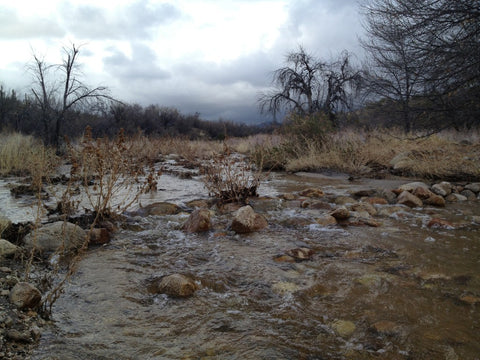Herbal Energetics: Person, Place, & Plant

The renaissance of herbal energetics amongst Western herbalists over the past 20 years or so has seen an even more recent surge of popularity amongst a subsection of this inspired group of plant lovers and herbal medicine enthusiasts. Getting to know our herbal actions is an important part of becoming familiar with the use of herbs, but a knowledge of plant energetics through the development of relationship with living plants is a direct path to understanding the Nature of plants and the limitless ways they can be applied for healing.

Oshá: Warm & Dry, upward and outward moving. *Shows us how to be upright, have integrity, fairness, righteousness, and make healthy, enduring pacts with ourselves, showing us there is nothing to cover up.
The history of herbal energetics is complex and has been practiced amongst various cultures across the globe. Our current extant knowledge, collectively as a human race, traces as far back as the ancient culture who settled the upper Indus Valley. Known as the Ayurvedic model, their cosmology focuses on three basic tendencies towards disease (Kapha, Pitta, Vata) each of which is comprised of a mixture of the 4 basic elements (air, earth, fire, and water). Thus, herbs are categorized as to how they affect each of these states, and to what degree they contain these various elements. Presumably, Ayurveda predates all other systems, if not influencing them as well. Arguably, other unknown, long-forgotten systems (uncommitted to any form of writing) may pre-date these works as well.

Other ancient systems of herbal energetic classification exist within the cultures of the Chinese, Japanese, Greek, Thai (Siam), Maya, Arabian, Aztec, and many others. Several of these systems have gained notoriety in the West via students bringing what they’ve learned abroad back home to Europe, North America, or Australia, or through the advent of globalism via greater cultural dispersion following the Industrial Revolution and the first two world wars. Several Westerners have rediscovered the origins of our own systems of herbal classification which have experienced numerous interruptions in their development over time (migrations, forced and otherwise, from Europe, massive disease epidemics, displacement, witch hunts, and finally the AMA’s territorial battle which forced all Eclectic and natural medicine-based institutions in North America to close their doors by the early 1940’s). The foundation of which, essentially, is the Galenic model, which built upon the Four Humours model derived from ancient Greece. In turn, Unani Tibb (derived from Greek Humoural Theory, or Humouralism), developed across the Arabic world, brought medicine, arguably, to its greatest heights in all the land from the 10th through the 17th centuries.

Initially inspired by the work of the Chinese and their elaborate classification of herbs either based upon yin-yang Taoist philosophy, or the 5 Element theory, I felt compelled to match up our local flora with these concepts in order to put it into an organized system which I could apply to each unique situation as it would arise. I noticed that no such system had been developed (to my knowledge) within this region. Perhaps this was a consequence of a lack of a formal system of writing by the former inhabitants, or a rather “uncivilized” life which bred far fewer illnesses or less of a need for “tonics” – as I first came to know them in Chinese medicine – as their daily life which regularly intermingled with environments only lightly touched by human hands had led to a vitality which became too uncommon in a more sedentary, highly agricultural and urbanized lifestyle (well known throughout the areas where complex systems of medicine had arisen).
Here in the Sonoran desert, where I have dedicated the better part of the past 14 years studying the rich diversity of plants and place this bioregion offers, I have been taught by the people who’s ancestors have inhabited this land for centuries, if not millennia, and by the place itself. The nuanced meanings coming through the subtle shifts in seasonal changes and the plants’, animals’, and insects’ responses to them comprise a cosmology which informs the bioregional herbalist – or one who connects deeply with their environment in order to access information and move into a place of healing.
I was learning that a system of medicine arises from the place, the people within it, and the Nature of the substances therein (plants, animals, insects, minerals, etc.). The truest theories will conform to the actions implicit in the expressions of the surrounding and encompassing Nature.

Cold, dark phlegmatic presence of late winter with an element of melancholy on its wings
I like to say that the Nature of a plant is expressed in many ways – one of which is its Energetics – and all aspects of its Nature comprise its medicine. The Energetics are expressed physiologically when we ingest herbs, and, in turn, elicit an array of feelings, emotions, if not imagery, for many. These impressions can be felt instantaneously, once the remedy touches the tongue, or, perhaps, when it is but touched in hand. Thus, explaining its physiological backdrop, or rationale, makes for an awkward task as our current scientific “knowledge” in this area can often do no such thing. Instead, we feel. We ride the wave of sensation, and with it, to some extent, the spirit of the medicine, imbued with the messages and wisdom of its homeland, the landscape, and now permeating our cells and conversing with our DNA. Our logical minds must simply learn to step away, rest, come back when the call to duty is on their terms, and allow for the imminent and all pervasive feeling sense to emerge, to become fluid within this exchange we call healing.
This process is ongoing and never complete. We are becoming and undoing, simultaneously. Through this cascade of changes and embarkations we dance with all of life, we enter the vehicle, we become the vehicle.
Exploring the Energetics of Herbs is exciting, enlightening, and ultimately a profoundly healing journey, especially when done with a group of committed students to the plants. I am happy to be facilitating such an experience through my Sonoran Herbalist Apprenticeship Program March 5 & 6 in Tucson, AZ.
You can Register for this Course HERE.


Leave a comment